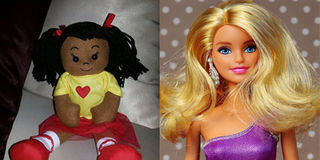ONEYA: What blue-eyed blonde bombshell Barbie has taught me

Barbie, long the stereotypical blue-eyed blonde bombshell, has found a place in our lives next to Iminza the African doll despite a spirited fight to keep the former away. PHOTO | AFP. PHOTO | BANG SHOWBIZ
What you need to know:
- One reader liked the article so much that bought my daughter an African doll named Iminza and personally delivered it to the office.
- Iminza had chocolate skin, black bead eyes, stringy black hair and a permanent smile.
- Do you feedback on this article? Please email: [email protected]
I once asked potential guests to my daughter’s first birthday to desist from bringing Barbie dolls as gifts. I specifically meant the blue-eyed blonde bombshell kind.
And no pink, please! I added in a Tweet a few days later.
So belligerent was my tone in the newspaper article, it seems, that one of the guests specifically brought her a navy blue sailor dress.
“I don’t think you can get any further from pink than this and I did not want to risk appearing in one of your articles,” she joked as she handed over the gift.
But as pompous as the article had been, it was no joke.
“I have nothing against Barbie dolls per se, I just have a problem with the things Barbie will tell my daughter about her looks. I would like her to grow up with the assurance that there is nothing wrong with her skin colour, even though the world might see it differently. If my guests cannot find black dolls that look like her, then I will suggest they buy her books, or trucks, or pretty dresses, items that will delight her but not set her on the path of questioning her skin colour and aspiring to 'untint',” I said.
PRAISE AND REBUKE
And the article attracted praise and rebuke in equal measure.
One reader liked the article so much that she bought my daughter an African doll named Iminza. She personally delivered it to the office. Iminza had chocolate skin, black bead eyes, stringy black hair and a permanent smile.
My daughter loved it immediately and would not sleep without it.
But a friend, commenting on the story on Facebook, rebuked me for limiting my daughter’s experience of the world.
“Is the world just full of black people? Why not teach her about different skin colours and cultures by letting her know that black, white and brown can exist side by side?” she asked.
I don’t remember my response, but it must have been something defensive and self-righteous. As explained, my article was quite pompous and as an Africanist and feminist, sometimes those are the only filters through which I see the world.
But I hadn’t counted on motherhood mellowing me and a few birthdays later—she is now four years old—plastic-eyed buxom dolls have crept their way into the toy box. They were five at my last count and if her father keeps giving in to her demands for more 'children' because that is how she refers to them, then we will soon need to move them into their own bedroom.
GALAXY OF REASONS
Of course, my galaxy of reasons for not allowing Barbie dolls in our lives eventually melted away when I saw the stars in my daughter’s eyes whenever she spotted them and how tenderly she cared for them (we are talking of daily baths here).
My daughter’s preference for white Barbie dolls over mommy’s favourite Iminza don’t just speak to the world’s view of beauty but also the influence of cartoon programmes that she watches.
There is nobody who looks like her on TV. At least not in the children's programmes she watches.
Filmmaker Ng’endo Mukii aptly captures the infestation of media-created beauty ideals in the film Yellow Fever.
Yellow Fever is a powerful short animated film that explores the effect of media-created ideals on African women and their perception of beauty.
One of the characters in the film is Ng’endo’s five-year-old niece who is sitting in front of the TV watching Western programmes, wishing she were a few shades lighter and says that she can change her colour through “magic”.
“If I had magic, I would change myself into white skin and white hair.”
Heart-breaking as it is to think about our children longing to change their skin tones, I realised that there is not really much we can do about Barbie dolls and her friends except use them to teach that different does not always mean better. And that in the ideal world, all colours are equal.
And there is no need to fight Barbie dolls because they are not the problem. We are.
In the words of Frantz Fanon, in Black Skin, White Masks: “Superiority? Inferiority? Why not simply try to touch the other, feel the other, discover each other?”
***
Do you feedback on this article? Please email: [email protected]





